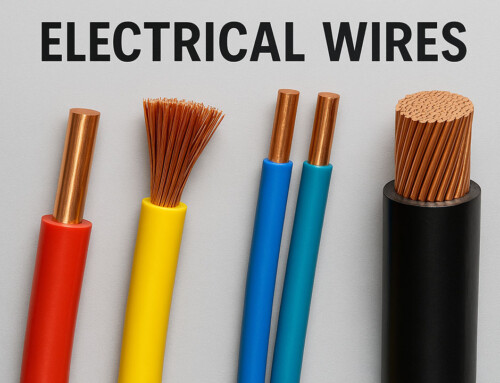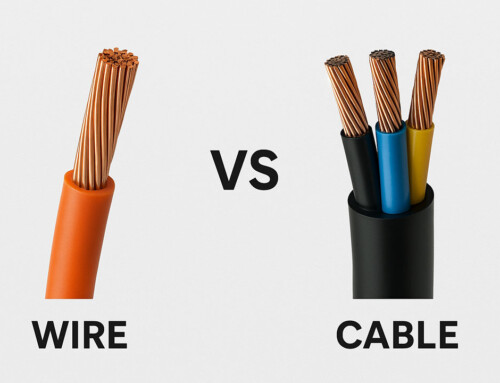Table of Contents
In electrical work, it’s not just about connecting circuits—it’s also about picking the correct wires for the job. Wire gauges might seem complicated, but using the wrong sizes can cause serious problems, like poor performance or even dangerous situations. In this guide, we’ll explain wire gauge charts and how to use them safely.
What is a Wire Gauge?
Understanding wire gauge is important for figuring out wire thickness. Each gauge is given a number, where lower numbers mean thicker wires and higher numbers mean thinner ones.
American Wire Gauge (AWG) is the standard for measuring wire thickness in the U.S. It’s used for electrically conductive wires, especially for specifying gauges for round and solid wires made from non-ferrous materials. It helps professionals figure out which wires are best for different jobs. Since wire thickness affects how well it conducts electricity, knowing the gauge is essential. This knowledge also helps everyone involved in the process, from the manufacturer to the consumer, communicate clearly about which wires to use.
Why Understanding Wire Gauges Matters?
When picking out the right wire for an electrical job, the gauge matters a lot. But figuring out which gauge to use isn’t always straightforward. For instance, if you’re dealing with circuits that carry a lot of electricity, you’ll need thicker wires to handle the load without getting too hot. If the wire is too thin for the job, it might fail or even catch fire. To avoid these problems, you’ve got to calculate how much electricity the system will use, considering factors like the planned load, connected load, and how long the circuit is. Then, you can choose a wire that can handle that amount of electricity safely and reliably.
Wire Gauge Chart
| AWG | Diameter (in) | Diameter (mm) | Resistance (Ohms/1000 ft) | Resistance (Ohms/km) | Max Amps (Chassis Wiring) | Max Amps (Power Transmission) |
| OOOO | 0.46 | 11.684 | 0.049 | 0.16072 | 380 | 302 |
| OOO | 0.4096 | 10.404 | 0.0618 | 0.202704 | 328 | 239 |
| OO | 0.3648 | 9.266 | 0.0779 | 0.255512 | 283 | 190 |
| 0 | 0.3249 | 8.252 | 0.0983 | 0.322424 | 245 | 150 |
| 1 | 0.2893 | 7.348 | 0.1239 | 0.406392 | 211 | 119 |
| 2 | 0.2576 | 6.543 | 0.1563 | 0.512664 | 181 | 94 |
| 3 | 0.2294 | 5.827 | 0.197 | 0.64616 | 158 | 75 |
| 4 | 0.2043 | 5.189 | 0.2485 | 0.81508 | 135 | 60 |
| 5 | 0.1819 | 4.62 | 0.3133 | 1.027624 | 118 | 47 |
| 6 | 0.162 | 4.115 | 0.3951 | 1.295928 | 101 | 37 |
| 7 | 0.1443 | 3.665 | 0.4982 | 1.634096 | 89 | 30 |
| 8 | 0.1285 | 3.264 | 0.6282 | 2.060496 | 73 | 24 |
| 9 | 0.1144 | 2.906 | 0.7921 | 2.598088 | 64 | 19 |
| 10 | 0.1019 | 2.588 | 0.9989 | 3.276392 | 55 | 15 |
| 11 | 0.0907 | 2.304 | 1.26 | 4.1328 | 47 | 12 |
| 12 | 0.0808 | 2.052 | 1.588 | 5.20864 | 41 | 9.3 |
| 13 | 0.072 | 1.829 | 2.003 | 6.56984 | 35 | 7.4 |
| 14 | 0.0641 | 1.628 | 2.525 | 8.282 | 32 | 5.9 |
| 15 | 0.0571 | 1.45 | 3.184 | 10.44352 | 28 | 4.7 |
| 16 | 0.0508 | 1.29 | 4.016 | 13.17248 | 22 | 3.7 |
| 17 | 0.0453 | 1.151 | 5.064 | 16.60992 | 19 | 2.9 |
| 18 | 0.0403 | 1.024 | 6.385 | 20.9428 | 16 | 2.3 |
| 19 | 0.0359 | 0.912 | 8.051 | 26.40728 | 14 | 1.8 |
| 20 | 0.032 | 0.813 | 10.15 | 33.292 | 11 | 1.5 |
| 21 | 0.0285 | 0.724 | 12.8 | 41.984 | 9 | 1.2 |
| 22 | 0.0254 | 0.645 | 16.14 | 52.9392 | 7 | 0.92 |
| 23 | 0.0226 | 0.574 | 20.36 | 66.7808 | 4.7 | 0.729 |
| 24 | 0.0201 | 0.511 | 25.67 | 84.1976 | 3.5 | 0.577 |
| 25 | 0.0179 | 0.455 | 32.37 | 106.1736 | 2.7 | 0.457 |
| 26 | 0.0159 | 0.404 | 40.81 | 133.8568 | 2.2 | 0.361 |
| 27 | 0.0142 | 0.361 | 51.47 | 168.8216 | 1.7 | 0.288 |
| 28 | 0.0126 | 0.32 | 64.9 | 212.872 | 1.4 | 0.226 |
| 29 | 0.0113 | 0.287 | 81.83 | 268.4024 | 1.2 | 0.182 |
| 30 | 0.01 | 0.254 | 103.2 | 338.496 | 0.86 | 0.142 |
| 31 | 0.0089 | 0.226 | 130.1 | 426.728 | 0.7 | 0.113 |
| 32 | 0.008 | 0.203 | 164.1 | 538.248 | 0.53 | 0.091 |
| 33 (Metric 2.0) | 0.00787 | 0.2 | 169.39 | 555.61 | 0.51 | 0.088 |
| 34 | 0.0063 | 0.16 | 260.9 | 855.752 | 0.33 | 0.056 |
| 35 (Metric 1.4) | 0.00551 | 0.14 | 339 | 1114 | 0.26 | 0.043 |
| 36 (Metric 1.25) | 0.00492 | 0.125 | 428.2 | 1404 | 0.2 | 0.034 |
| 37 (Metric 1.12) | 0.00441 | 0.112 | 533.8 | 1750 | 0.163 | 0.0277 |
| 38 (Metric 1.0) | 0.00394 | 0.1 | 670.2 | 2198 | 0.126 | 0.0225 |
| 39 | 0.0035 | 0.089 | 831.8 | 2728 | 0.11 | 0.0175 |
| 40 | 0.0031 | 0.079 | 1049 | 3440 | 0.09 | 0.0137 |
Reading a Wire Gauge Chart
Ever stared at a wire gauge chart and felt lost? This section will break down the key terms and numbers you’ll find on these charts, helping you choose the right wire for your project.
-
AWG (American Wire Gauge):
Pay close attention to this one! Lower AWG numbers mean thicker wires. In general, thicker is better for electrical projects.
-
Size (Diameter):
This column shows the actual diameter of the wire, in inches or millimeters. Bigger numbers mean a thicker wire.
-
Area (mm²):
This column displays the cross-sectional area of the wire. A larger area allows for more current to flow safely.
-
Resistance (Ohms/1000 ft or Ohms/km):
Resistance is like friction for electricity. Thicker wires (lower AWG) have less resistance, so more current can flow with less power loss.
-
Max Current (Amperes):
This value indicates the maximum safe current the wire can handle before overheating. Thicker wires can handle higher currents.
-
Max Frequency (MHz):
This is important for high-frequency uses. It shows the highest frequency before the “skin effect” becomes a problem. The skin effect is when current concentrates on the outer part of the wire at high frequencies, making it act more resistant. Thicker wires can handle higher frequencies before this becomes an issue.
How to use this table:
- Determine your load: What’s the amperage (current) the devices you’ll be connecting will draw?
- Choose the wire gauge: Find the wire gauge on the table with a “Max Amps” rating that equals or slightly exceeds your required amperage.
Remember:
- Thicker wires (lower AWG) are generally better for carrying more current with less resistance.
- Use the chart to choose the right size wire for your project based on the current you need and the length of the wire run.
- Consider frequency if you’re working with high-frequency applications.
Commonly Used Wire Gauge Size and its Uses
Different wire sizes have specific purposes in electrical work. Here’s a rundown of some common sizes and where they’re typically used:
- 18 AWG: This size is commonly used for low-voltage applications such as thermostats and doorbells.
- 14 AWG: Typically found in 15-amp lighting circuits, as well as in outlets in bedrooms and offices.
- 12 AWG: Used for 20-amp outlets, particularly in areas like kitchens and bathrooms where devices drawing more current are present.
- 10 AWG: Used in 30-amp circuits powering appliances like small electric ovens and washing machines.
- 8 AWG: Commonly seen in smaller ovens and air conditioning units.
- 6 AWG: Typically used for electric ovens and car chargers.
- 2 AWG: For heavier loads, single conductors like 4 AWG, 2 AWG, and larger are used for appliances like hot tubs, air conditioning units, and subpanels.
- 3/0 AWG: Reserved for wiring 200-amp residential service.
Closing Thoughts
Choosing the right wire size is important for any electrical project. Wire gauge charts can seem complex, but this guide has explained what they are and how to use them. By following these tips, you can pick the perfect wire for the job. Remember, thicker wires (lower AWG numbers) can handle more current. Keep in mind the amperage you need, the length of the wire run, and any frequency considerations. This will help you make safe and smart choices about the wires you use in your electrical projects.






